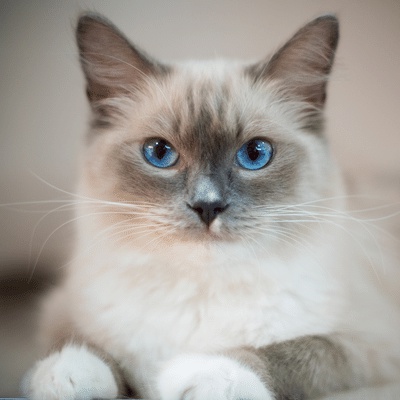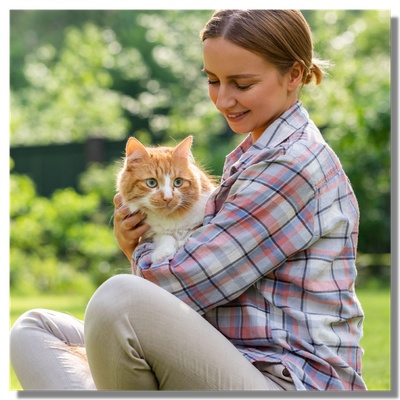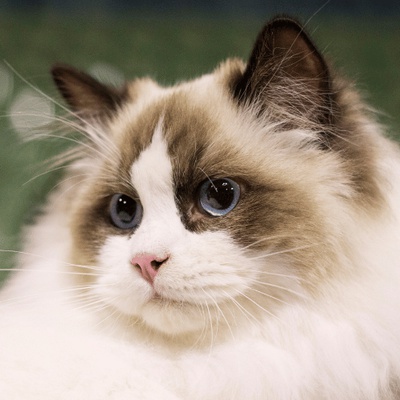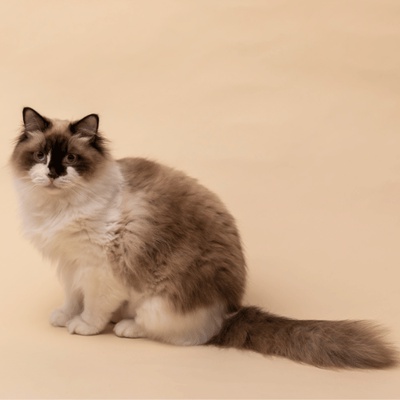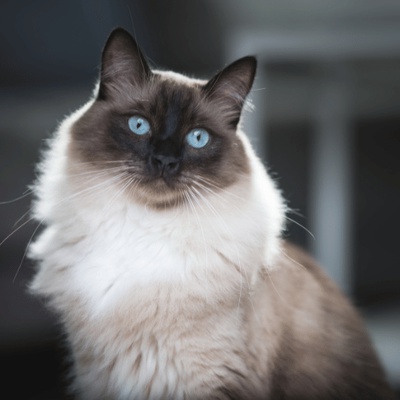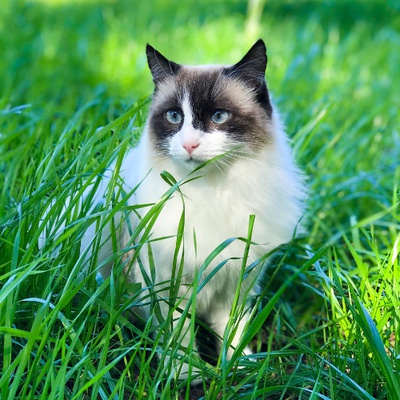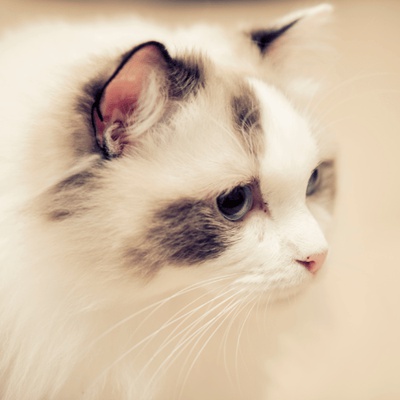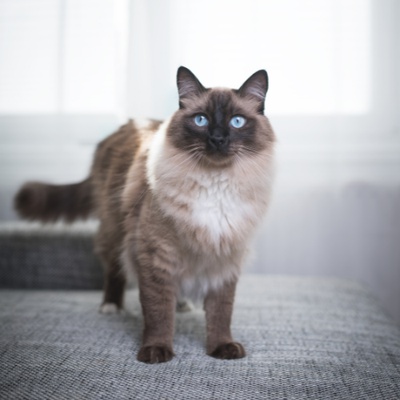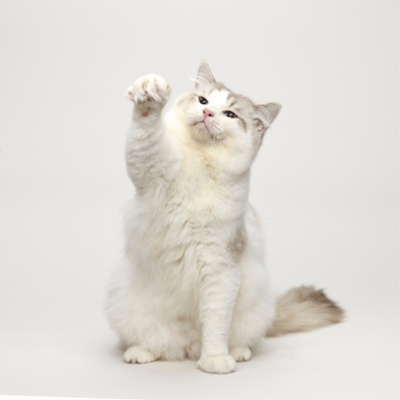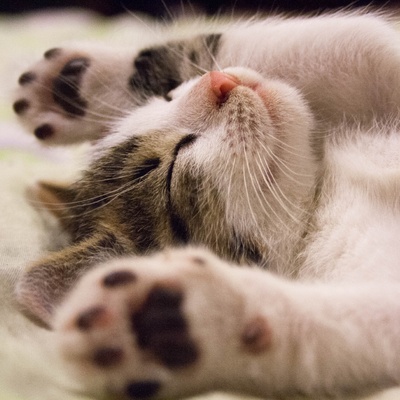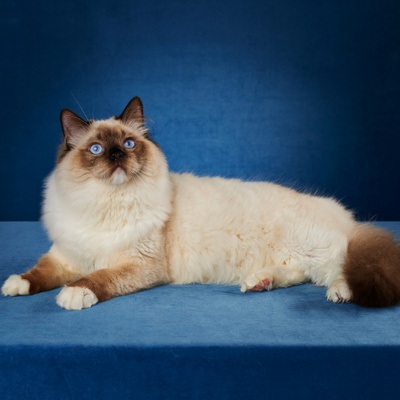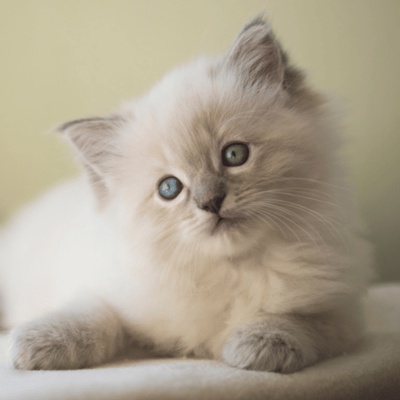Introducing the Ragdoll
Find out everything you need to know about the Ragdoll: its characteristics, its behaviour, its training and how much one costs.
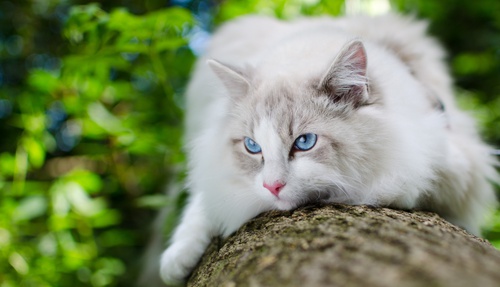
Find out everything you need to know about the Ragdoll: its characteristics, its behaviour, its training and how much one costs.
The Ragdoll is a very new breed of cat that was introduced in the 1960s in California, USA. A cross between a Birman and a Persian Angora, the Ragdoll is a unique and incredibly gentle cat. A very affectionate breed, it needs to form a strong bond with its owner to feel happy and fulfilled. This cat has a lot of love to give and likes to be loved back. The Ragdoll is the ideal companion in every way.
This section outlines the unique features of the Ragdoll breed of cat.
The Ragdoll is one of the biggest cat breeds, with a large and muscular build, measuring up to 15 inches tall and up to 39 inches long.
The Ragdoll is a very hairy cat! It has medium-length fur with hardly any undercoat, which gives it an unbelievably soft and silky feel.
The Ragdoll is not a hypoallergenic cat. However, its coat is much less irritating than other breeds.
The Ragdoll coat can vary in colour between cream, brown, lilac and chocolate. The coat can also be bi-colour or colourpoint (darker extremities).
The Ragdoll is a very easy-going cat that adapts easily to any environment. It's the perfect apartment cat. Town or country, the Ragdoll will be happy anywhere!
The Ragdoll is not a solitary breed, quite the contrary in fact! They are very sociable and love the company of other cats and humans.
This breed of cat does not have any specific health problems. Nevertheless, some Ragdolls can suffer from hereditary conditions.
You won't find a more placid cat! The Ragdoll is easy to train and very attentive. Ragdoll cats are devoted to their owners and demand a lot of love and affection.
We can help you!
Every cat has its own character and specific needs. Making the right choice will ensure his well-being and yours.
Thanks to our quiz, you'll know which breed is right for you, depending on your lifestyle, expectations and many other criteria.
Don't wait any longer and take the quiz to find out the answer!
The Ragdoll is one of the biggest purebred cats, along with the Maine Coon. Its main characteristic is its incredibly soft, silky coat and how much it resembles a big cuddly toy!
The Ragdoll is a large breed of cat. The average female Ragdoll is 13 inches tall. The male is typically around 13,5 inches tall and can easily reach 15,5 inches. And that’s not all. A male can reach up to a metre in length, from his nose to the tip of his tail.
As for weight, males are heavier than females. A male Ragdoll can weigh from 6,5 to 22 pounds while a female weighs on average between 6,5 and 15 pounds. The Ragdoll has a very big build. Hidden under all that fur is a muscular body and a broad chest.
To see its adult size, you will have to wait until it is 3 or 4 years old, which is the average age at which a Ragdoll cat finishes growing.
The Ragdoll's thick coat has its own distinctive features. It has a medium-length coat of uneven length. Its hair is longer and thicker on its neck, giving it a "lion's mane". It also has long hair on his rump, hind legs and tail. The Ragdoll is not a hypoallergenic breed and has very little undercoat underneath its silky coat, which helps to prevent tangles from forming.
The colour of its coat is also quite distinctive. Like the Siamese and the Birman, the Ragdoll is a colourpoint cat. Kittens born with a white or cream coat will develop a darker colour on their legs, head, ears and tail as they grow. The Ragdoll coat can also be:
As for colours, the Ragdoll can have a chocolate, seal, blue, lilac, red or cream coat. The colour can be tabby (striped) or tortie (with red spots).
In addition to its size and coat, the Ragdoll has a few more surprises in store. This is a powerful cat with a wide head, a straight muzzle and an imposing chin. It has a broad chest and strong muscles. Also, like the Maine Coon, it has hair between its paw pads.
Unlike the Maine Coon though, the Ragdoll has large, low-set ears that are rounded at the tip. Its big, bright, oval eyes and its long, shaded tail tone down its bold, rugged, appearance and turn it into the cutest cat.
The Ragdoll has a stunning coat that needs careful looking after. It should be brushed at least once a week. You should get your Ragdoll kitten used to being groomed from a very early age! When moulting, they will need more frequent grooming.
Cats clean themselves and a Ragdoll rarely needs a bath. An indoor cat by nature, a Ragdoll should only be washed if they get particularly dirty. You can wash them with a flannel or give them a little bath. Just make sure you use suitable shampoo.
The Ragdoll is a sweet, patient and cuddly cat! They are the ultimate feline friend.
A Ragdoll is a genuine bundle of love! It may look a little like a lion cub but it’s actually a very affectionate cat, easy to live with and exceptionally good natured. To thrive, they need attention and a lot of love, they want to feel that they matter to you.
The Ragdoll is also a very sociable creature and is the ideal pet for families and children. They don't like to be alone and love to shower affection on anyone who will let them. The Ragdoll gets on well with other cats and with all kinds of pets.
Like all cats, it likes to play with little toys and other objects. Very patient and placid, when they find themselves in an unpleasant situation, they prefer to retreat elsewhere to cool off rather than get their claws out.
The Ragdoll cat is named after the child’s toy, a rag doll. When you hold them, they relax completely and let themselves be petted and snuggled. They feel just like a cuddly toy! Ragdolls love being carried and being held by their owners.
The Ragdoll is extremely adaptable. It will live quite happily anywhere. Having said that, its desire for companionship explains why it's often better suited to living in a flat than in a large house.
Ragdoll cats aren't particularly adventurous, but their carefree nature and friendliness can sometimes land them in trouble. You should make sure your Ragdoll doesn't go out unsupervised, as they could end up having an accident. All you need to make a Ragdoll happy is a cat tree, some toys and a whole lot of love!
The Ragdoll is a gentle and easy to train cat. Its unfailing love and loyalty naturally make the Ragdoll an obedient and devoted cat. It is an attentive cat that is very responsive to its owner. As early as kittenhood, you can teach it basic commands that will last a lifetime!
Choosing a cat that matches your personality and lifestyle will ensure your well-being and his!
The Ragdoll is a hardy breed of cat with no particular health problems.
Ragdoll cats enjoy robust health and are rarely ill. However, like many other cats, a Ragdoll can suffer from hereditary conditions like feline hypertrophic cardiomyopathy, a thickening of the heart’s muscular walls. They could also develop polycystic kidney disease, which causes cysts to form in the kidneys. A DNA test will pick up any potential disorders. This simple test allows the gene to be identified and prevented from being passed on.
Like all cats, a Ragdoll needs to visit the vet to be vaccinated against common diseases like Feline infectious enteritis (FIE), Cat Flu, and Feline leukaemia virus (FeLV).
The Ragdoll is a huge, muscular cat. To keep your cat in shape, and more importantly, healthy, you should feed high quality kibble. If you want to supplement the kibble, you can choose green vegetables with a high water content. This will help support your Ragdoll's normal kidney function.
Like the Maine Coon, the Ragdoll is a slow grower. They reach their adult weight at around 3-4 years of age, so their diet must be appropriate and carefully controlled. Make sure you stick to the same brand of kibble and feed your cat at set times to avoid upsetting their digestive system.
The Ragdoll is not particularly athletic and would honestly rather lounge on the sofa than go out chasing mice. So, if their diet isn't carefully controlled and they don't get enough exercise, Ragdolls can quickly become overweight and this can of course lead to serious health problems. So get your cat moving! Make them play, run, jump, they never turn down a chance to play with their owner.
So, you’ve got your heart set on a Ragdoll. Find out more about adoption and price.
Pedigree cats like Ragdolls are usually bred by professional breeders or catteries. Before you adopt your cat, it’s a good idea to pay a visit to see how they are being kept.
From June 10, 2024 you must have your cat microchipped by the age of 20 weeks old and register its details in a relevant database such as Petlog or The Governing Council of the Cat Fancy (GCCF). This is a legal requirement in Britain, and failure to comply could result in a fine of
.
It’s also important to check that all the necessary health checks and DNA tests have been carried out on the kitten and its parents so that you are aware of any hereditary health problems.
The price of a purebred Ragdoll varies depending on a number of factors including gender, lineage, pedigree, age and breeding potential. The price can vary from
to
. You can also choose to adopt an adult Ragdoll. They are cheaper, typically between
and
.
In addition to the purchase price, a cat has day-to-day living requirements and needs to be cared for throughout its life. These expenses need to be considered and accounted for.
The Ragdoll has an average life expectancy of 12 to 15 years. That's a serious commitment and a decision that’s not to be taken lightly. Adopting a Ragdoll is for life!
Choosing a dog that matches your personality and lifestyle will ensure your well-being and his!
To access the most relevant information, suitable payment methods, and delivery in your region, please select the website corresponding to your country.
